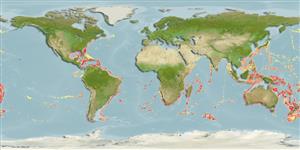>
Acropomatiformes (Oceanic basses) >
Epigonidae (Deepwater cardinalfishes)
Etymology: Epigonus: Greek, epi = over, in front + Greek, gonio = angle (Ref. 45335).
Environment: milieu / climate zone / depth range / distribution range
Écologie
marin; saumâtre bathydémersal; profondeur 550 - 1300 m (Ref. 31632). Deep-water
Indo-Pacific: Tanzania to Viet Nam (Ref. 31632), Indonesia (Ref. 26165) and western Australia. Western Atlantic: Florida, USA (Ref. 31632) to Suriname and French Guiana (Ref. 13608).
Taille / Poids / Âge
Maturity: Lm ? range ? - ? cm
Max length : 21.2 cm SL mâle / non sexé; (Ref. 26165)
No opercular spines. 8 spines on first dorsal fin. Pyloric caeca 7-8 (light organ present in one of the caeca). Premaxillary teeth elongated, thin, remain visible when mouth closed (Ref. 31632).
A mesobenthic-pelagic species living mainly above the bottom (Ref. 31632). Found on the continental slope (Ref. 7300).
Life cycle and mating behavior
Maturité | Reproduction | Frai | Œufs | Fécondité | Larves
Paxton, J.R., D.F. Hoese, G.R. Allen and J.E. Hanley, 1989. Pisces. Petromyzontidae to Carangidae. Zoological Catalogue of Australia, Vol. 7. Australian Government Publishing Service, Canberra, 665 p. (Ref. 7300)
Statut dans la liste rouge de l'IUCN (Ref. 130435: Version 2024-2)
Menace pour l'homme
Harmless
Utilisations par l'homme
Outils
Articles particuliers
Télécharger en XML
Sources Internet
Estimates based on models
Preferred temperature (Ref.
123201): 2.9 - 9.6, mean 6.3 °C (based on 555 cells).
Phylogenetic diversity index (Ref.
82804): PD
50 = 0.5000 [Uniqueness, from 0.5 = low to 2.0 = high].
Bayesian length-weight: a=0.00646 (0.00275 - 0.01515), b=3.10 (2.89 - 3.31), in cm total length, based on LWR estimates for this (Sub)family-body shape (Ref.
93245).
Niveau trophique (Ref.
69278): 3.5 ±0.5 se; based on size and trophs of closest relatives
Résilience (Ref.
120179): Milieu, temps minimum de doublement de population : 1,4 à 4,4 années (Preliminary K or Fecundity.).
Fishing Vulnerability (Ref.
59153): Low vulnerability (16 of 100).
